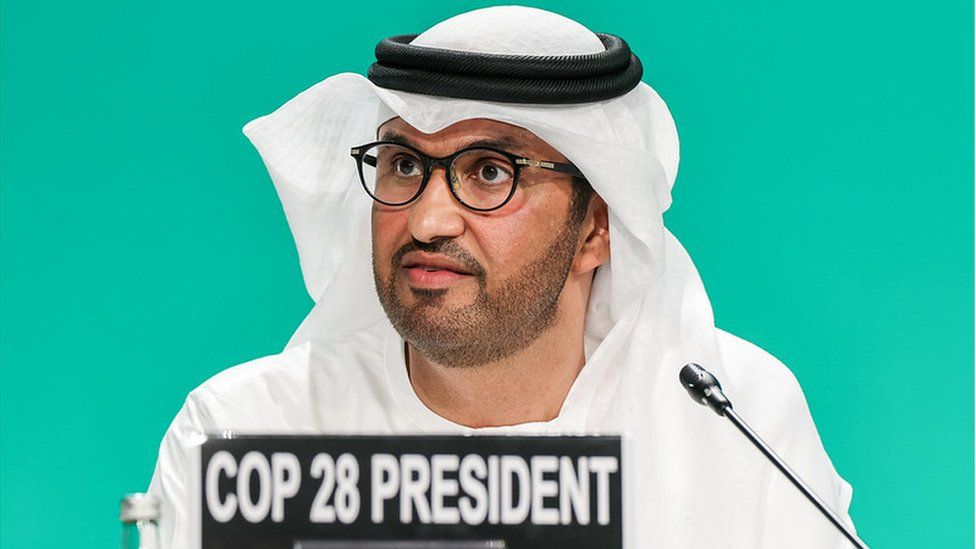28 minutes ago
About sharing
The country hosting COP28 climate talks aimed at cutting fossil fuel emissions is massively ramping up its own oil production, the BBC has learned.
The United Arab Emirates’ state oil firm Adnoc may drill 42% more by 2030, according to analysts considered the international gold standard in oil market intelligence.
Between 2023 and 2050, only Saudi Arabia is expected to produce more.
Adnoc says projections show capacity to produce oil, not actual production.
It said it had already clearly stated plans to boost its production capacity by 7% over the next four years.
The firm said it was widely accepted that some oil and gas would be needed in decades ahead and that it was making its activities more climate-friendly, including by expanding into renewable energy.
More on the COP28 climate summit
The major focus of COP28 is the phasing down or phasing out of fossil fuels including oil and gas.
Sultan al-Jaber is the president of the COP and the chief executive of Adnoc.
This new analysis of oil industry data suggests Adnoc is now in the process of rapid expansion.
The information on Adnoc comes from Rystad Energy, whose oil market intelligence is widely used and trusted by fossil fuel companies and international bodies such as the International Energy Agency.
Rystad uses company reports, government sources and academic research to make projections of future oil and gas production.
Campaigners Global Witness then used this data to make a list of top oil producers between now and 2050.
The UAE came second behind Saudi Arabia. It currently ranks 12th in the world.
Rystad said the 42% production increase this decade will raise output from just over a billion barrels in 2023 to almost 1.5 billion barrels by 2030.
The data suggests that this aggressive expansion is expected to continue through the 2030s, with production starting to decline in the 2040s.
By 2050 Adnoc is expected to be producing close to 850 million barrels of oil a year, significantly less than the billion it produces now.
Production is expected to fall across the world towards the mid-century.
Bill Hare, a senior scientist with Climate Analytics, said the “staggering” growth in Adnoc’s projected production “is completely against everything we know that needs to be done to limit warming to 1.5C”.
“It flies in the face of the the COP president’s own commitment to make 1.5C the North Star of the climate negotiations,” he added.
“This amount of oil and gas would bust the chances of limiting warming to 1.5C.”
Adnoc’s total production would still be dwarfed by Saudi Arabia’s national producer, Aramco, which will produce 101 billion barrels by 2050.
However, it would be significantly more than all five “supermajors” combined – these are Shell, BP, ExxonMobil, Chevron, TotalEnergies and ConocoPhillips.
According to the analysis, emissions from Adnoc’s increased production by 2050 will be over 14 billion tonnes of CO2, which experts say is over 6% of the Earth’s entire budget to keep temperatures under 1.5C.
Fatih Birol, the head of the International Energy Agency, said Adnoc’s expansion was not compatible with keeping global temperatures below dangerous thresholds.
“It is not possible for any fossil fuel company to say ‘I am going to increase my production by x million barrels of oil and at the same time my company’s strategy is in line with the Paris climate agreement’,” he said,
“Both of them at the same time, don’t work,” he told BBC News.
Adnoc said the analysis did not make any distinction between production capacity and actual production.
Companies often have the capacity to produce far more oil, but because of oversupply in the market, or restrictions placed on them by the OPEC cartel, they may not produce all of that capacity.
“We have clearly stated that we are growing our production capacity from around 4.65 million barrels per day to five million barrels per day by 2027. This represents a 7% increase in production capacity,” an Adnoc spokesperson said.
“It is important to note that this is capacity and not necessarily production. It also does not reflect Adnoc’s share of production.”
“All energy transition scenarios, including those by the IEA and Rystad, acknowledge that some level of oil and gas will be needed to meet future energy demand,” Adnoc added.
“We are producing some of the world’s least carbon intensive oil and gas and we are further reducing our carbon intensity by 25% by 2030 while making an initial investment of $15bn to decarbonize our operations and accelerate the growth of the energies of the future, including hydrogen, geothermal and renewables.”
Global Witness say they analysed “projected annualised hydrocarbon extraction rates”, meaning actual production, not production capacity.
They say this information is publicly available from Adnoc.
“These findings show how, irrespective of the outcome of COP28, Adnoc plans to produce more oil than nearly every operator on the planet and plans to vastly increase its output – in direct contravention of the scientific consensus around which Sultan al-Jaber is mandated to build negotiations in Dubai,” said Patrick Galey, from Global Witness.
There are many unknowns about future oil production and demand, which might influence supplies to the market. However green political leaders say that new oil drilling opportunities should not now be pursued.
“Sultan al-Jaber, as COP President and fossil CEO, must give the only right example now and come forward with a pledge to change Adnoc’s future plans,” said Bas Eickhout, a member of the Green Party in the European Parliament.
“Not only is his own credibility at stake, but it will also determine the success or failure of UAE’s COP Presidency.”
Graphics by Mark Poynting
